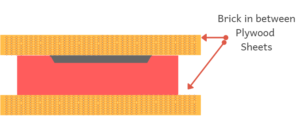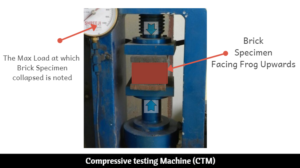The different types of tests conducted on bricks are already discussed in the article how to test the quality of brick on site. The Compressive strength test on bricks is done indoors in a lab and requires a specific apparatus to conduct the test.
Contents
First of all,
What is Compressive strength?
Compressive strength determines the load-carrying capacity of a material or an element. To understand clear, Let’s take an example of a boy weighs 12kg sitting on a small chair. The specific chair is made only for kids so that they can sit without any harm. Now say, an adult weighs 60kg sat on the chair, The chair is unable to carry the load of 60kg on it. Hence it will break. Same in the case of Building materials, there is a load-carrying capacity for any material upto an extent, once the limit is met the material starts failing.
Compressive Strength of Bricks:
Compressive strength of bricks is the capacity of brick to resist or withstand under compression when tested on Compressive testing machine [CTM]. The Compressive strength of a material is determined by the ability of the material to resist failure in the form of cracks and fissure.

In this test, the compression force is applied on both the faces of brick and the maximum compression that brick can bear without cracking is observed and recorded.

Classification of Bricks based on Compressive Strength:
IS 1077-1992 bricks are classified into 11 different types based on Compressive strength of a brick
Below table tabulates the Compressive strength of Brick of different classes:
Bricks Class Designation Average Compressive Strength not less than (N/mm2) (Kgf/cm2) 35 35 35 30 30.0 300 25 25.0 250 20 20.0 200 17.5 17.5 175 15 15.0 150 12.5 12.5 125 10 10.0 100 7.5 7.5 75 5 5.0 50 3.5 3.5 35
to remember the classification easily while selecting the right brick , the bricks are classified as
- First Class Brick: The brick which has a compressive strength of 10N/mm2 is called as a First class brick
- Second Class Brick: The brick with compressive strength of 7N/mm2 is called as a Second class brick
- Building brick: The brick which we use for building has a compressive strength of 3.5N/mm2
- Sundried Brick: The sun dried brick has a compressive strength of 1.5N/mm2 to 2.5N/mm2
Read: BrickWork Calculation | Types of Bricks | Bricks in Construction
Compressive Strength test on Bricks:
Apparatus:
Compressive testing machine [CTM], Three samples of bricks collected randomly from the brick pouch. Cement mortar of ratio 1:1 (1 Part of cement and 1 part of sand), Plywood sheets and trowel to fill the mortar in the brick frog is required.
Precautions:
- The sampling of bricks should be done carefully and the dimensions of bricks should be measured near to 1mm and ensure the three bricks have the same and equal size.
- Bricks without efflorescence are selected for the test.
- Clean water is used
Procedure:
- Three bricks are picked from the brick pouch and the unevenness on the brick faces are removed by grinding.
- Immerse the brick samples in the water for 24 hours at the temperature of 23-degree centigrade.
- Prepare the mortar by mixing the cement and sand at the ratio of 1:1.
- Fill the frog with the mortar paste and allow to set the bricks in jute bags for the period of 24hrs.

- Also, check for the voids on the brick surface. If there any fill the voids by flushing the mortar on them.
- Take out the bricks from bags and immerse them back in the water for 7 days to complete the hardening of mortar on brick.
- Allow the bricks to dry, before placing it on the compressive testing machine
- Place the specimen flat-wise on the base of CTM, with mortar filled face upwards between the two flat plywood sheets.

- Plywood sheets are used to hold the brick in the correct position while testing.
- Start the CTM and apply the load axially on the specimen at the rate of 14 N/mm2 (140 kg/cm2) per minute till the brick starts breaking.

- Repeat the same procedure with the leftover bricks
- Note down the reading of each brick from CTM once the brick starts tearing.
Observations :
Contact Area (Top face Area) = …………….mm2
Max Load at which the specimen (brick) starts breaking = ……………….N
Formula to calculate the Compressive strength:
Compressive Strength = Max load at which Specimen starts breaking (N) / Contact area (mm2)
The Standard size of brick is 190mm x 90mm x 90mm
Area = Length x width = 190×90 = 17,100Sq.mm
Suppose the max load at which the Brick starts cracking = 600KN
As per formulae,
Compressive strength of calculated bricks = 600×100 / 17100 = 35N/mm2
The same procedure is adopted and the average value is calculated.
Important notes: As per IS, at least three bricks are tested at 7 days and the average of the three bricks are rounded to nearest 0.5N/mm2. Do not consider the specimen which differs more than 10% of the average value of compressive strength.
References:
| IS 1077-1992 | Common Burnt Clay Building Bricks -Specification | View & Download |
Also Read:
Compressive Strength test of cement
Compressive strength test on concrete
For Instant updates Join our Whatsapp Broadcast. Save our Whatsapp contact +9700078271 as Civilread and Send us a message “JOIN”
Never Miss an update Click on “Allow US” and make us allow or Click on Red notification bell at bottom right and allow notifications.
Stay tuned! More are updated Soon!!.
Civil Read Wishes you ALL the BEST for your future..

